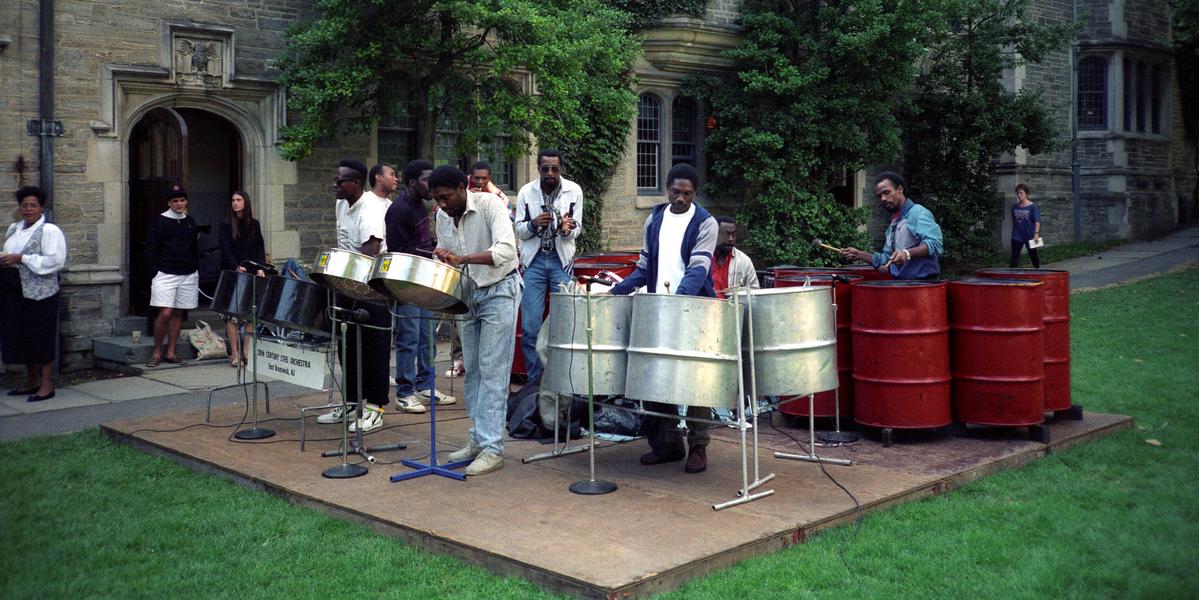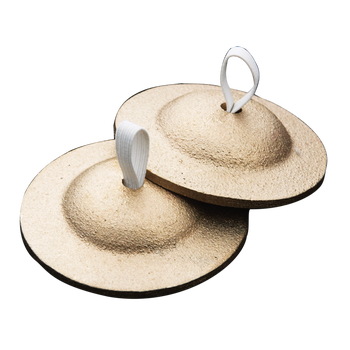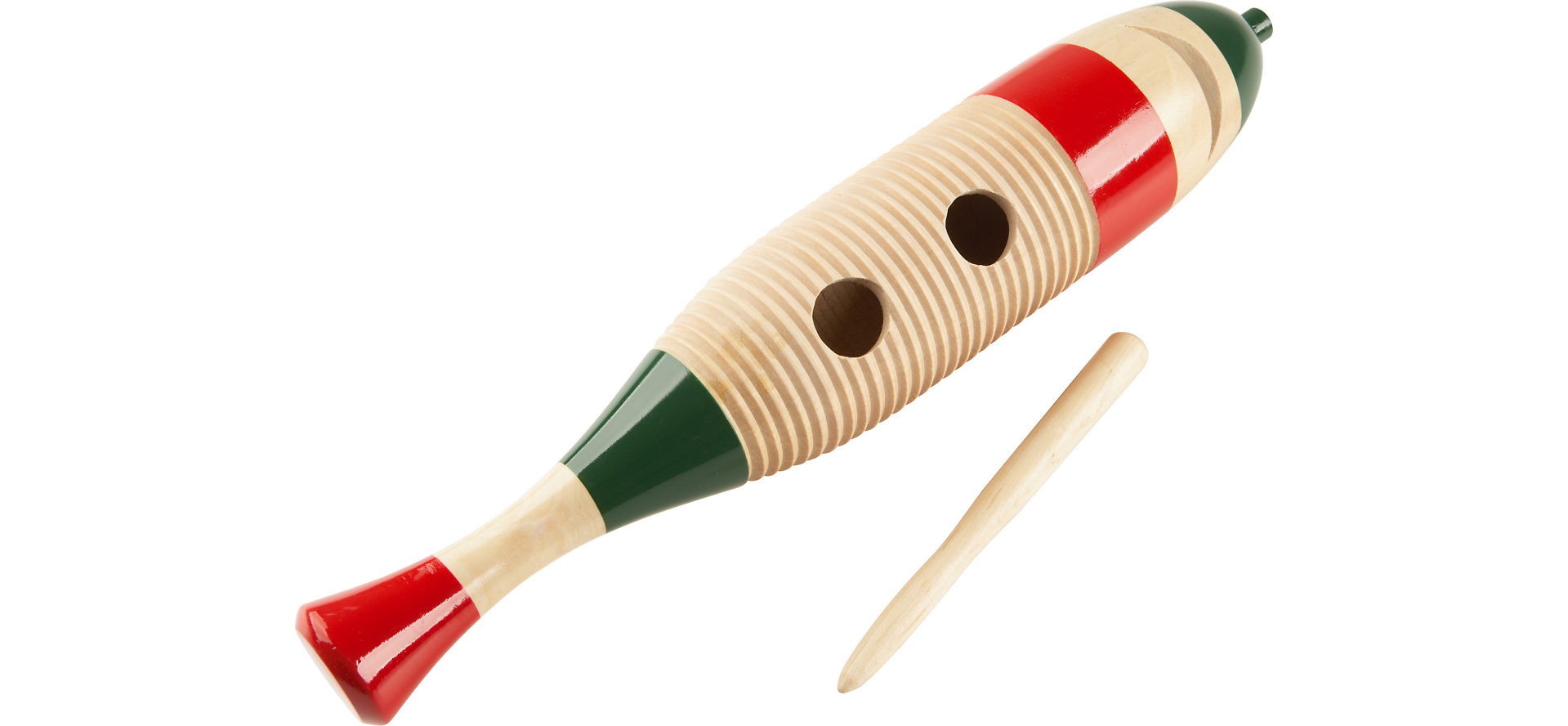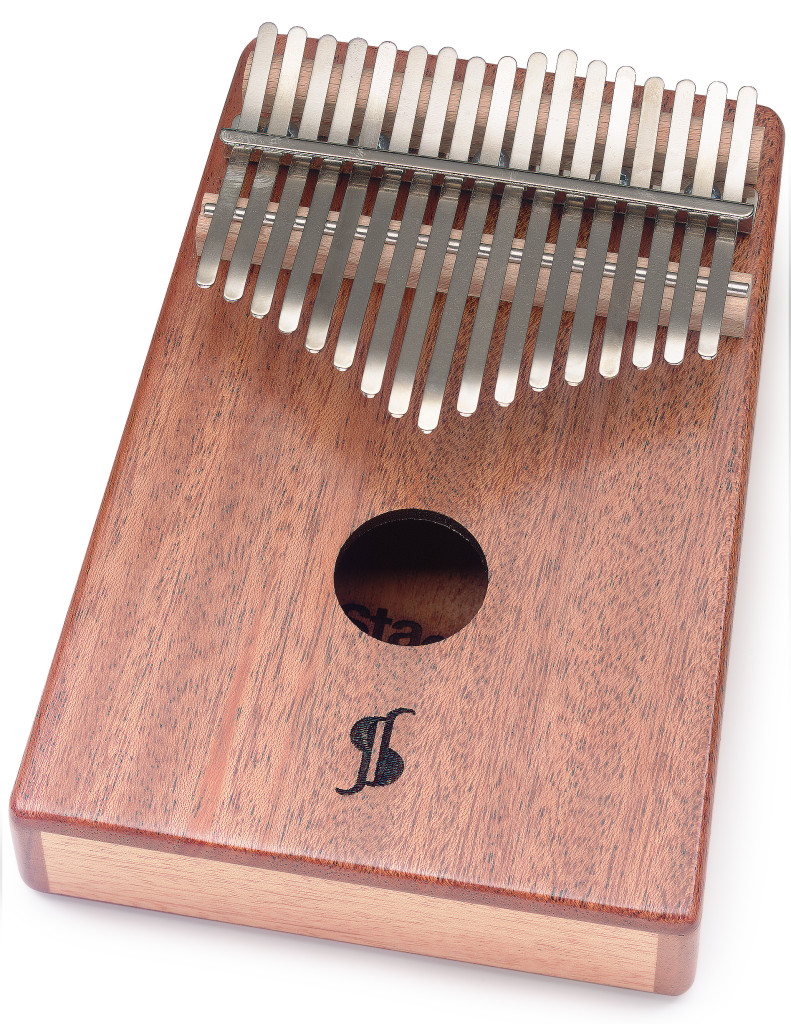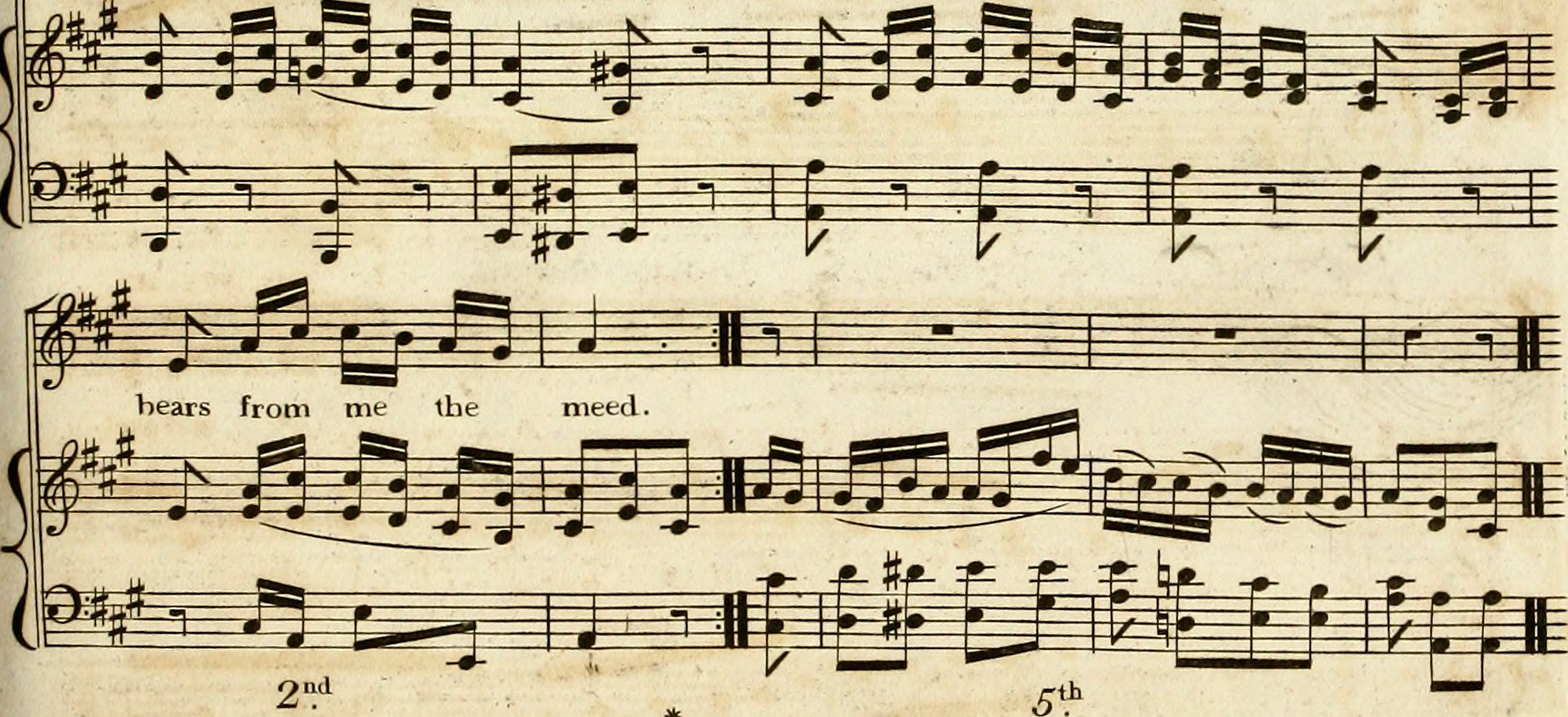What are Idiophones?
Clang. Clang. Clang.
The smell of incense fills the air, unfurling in a swirling mist through the still room. A single candle flickers, casting long shadows along the walls and floor. Rows of robed monks stand quietly, eyes down cast, breathing, listening to the cavernous sound of the temple bell as it fills the hall like incense smoke. In sacred spaces around the world, practitioners of every religion rely upon the beautiful and percussive sounds of the class of instruments known as idiophones.
So, what are idiophones exactly?
Idiophones are a percussive type of musical instrument that generate their sound through the vibrations of the material of their bodies. They are often constructed of a resonant material such as wood, metal, or stone, and do not require any extra strings, or taught membranes to produce their sound. Maracas, bells, and cymbals are common examples of idiophones.
And although the term “idiophone” may initially seem like a name more fit for clueless telemarketers, or perhaps may seem even a little foreign or alien to our minds, the instruments themselves have existed for centuries, perhaps for as long as human beings themselves have existed.
For example, throughout the ancient Greek and Roman world, bronze plates and bells were struck to ward off ghosts and malevolent spirits. Sometimes these bells were attached to Greek soldiers’ shields – this created a cacophonous clattering that was meant to strike fear into the hearts of any enemies that dared to oppose the mighty Greek warriors.
In Zimbabwe, among the Shona peoples, a specific and local type of lamellophone, also known as a thumb piano, called “likembe dza vadzimu” is still used today in ancestral worship ceremonies
Many churches have a handbell choir, where members each play up to two different pitched bells. When a practiced handbell choir softly begins to chime, the result is an ethereal and haunting soundscape that is capable of producing intricate melodic and harmonic passages that can send chills up and down your spine.
Buddhist temples around the world rely on a variety of pitched metal bells for their liturgical services. The different bells serve to communicate information between the practitioners as they prepare to chant their liturgy. In the tradition of Zen Buddhism, the chants are often marked in time with a percussive wooden bell known as the Mokugyo, or the “Wooden Fish.” Even the practice of meditating is bookended by the sounds of wooden clappers and small metallic bells.
Classification of Idiophones
In 1914 Erich Moritz von Hornbostel and Curt Sachs published a system for classifying musical instruments. Quite cleverly, they coined their new method of organization the “Hornbostel-Sachs” system, sorting instruments by the way that they vibrate to produce sounds.
Although this was by no means the only system of instrumental classification, it is largely viewed as the standardized method in many academic circles. Since its inception in the early 20th century, the Hornbostel-Sachs method has been revised and updated alongside humanity’s evolving technologies and thought.
Idiophones are one of five categories of instruments defined by Hornbostel and Sachs. The full list of categories includes: Idiophones, Membranophones, Chordophones, Aerophones, and electrophones – with electrophones, or instruments that produce their sound electronically, added much later.
It is from this classification system that the term “idiophone” was created to encompass and define instruments that produce their sound through the vibrations of their instrument body.
In an academic fervor, percussive idiophones have been broken down into subcategories, further defining these buzzing, clanging, scraping instruments into eight different kinds of idiophones.
A Family of Eight: The Members of the Idiophone Family
The house lights begin to dim, a nervous excitement crackling in the air as the stage lights flare, illuminating the quiet and still musicians. Suddenly, it begins, wide and ominous, the roaring sound of an upright bass as it dances against the syncopated rhythm of the drum set, and in a flash, the band is alive. Tonight, we are witnessing a Latin Jazz ensemble perform, and it’s hard to sit still; the rhythms are spicy and the stage is lush with a variety of percussive idiophones.
Concussion Idiophones
Off to the side, you might notice a person standing in a nook, quickly switching between an entire arsenal of hand percussion instruments. And right now, during this song, it looks like he is clacking two wooden sticks together. A staple in the Latin Jazz Ensemble, this instrument called the claves, creates a sharp and piercing click as the two sticks bounce off of each other. Claves are an example of a concussion idiophone, which create their sound when two resonant objects are struck together. In this case, our two objects of interest are simple hardwood sticks.
Other examples of concussion idiophones include instruments like the castanets, which are small, hollowed, hardwood clappers that are connected by a hinge and attached to a string. Cymbals, like you might see on a drum set or in a marching band, are also instruments in the concussion idiophone family.
Percussion Idiophones
The drums are pounding furiously, yet somehow sound light and floating. The bass player has his eyes closed and is sweating under the stage lights as he lays out a complementary groove next to the drum set. The piano is swelling, and the volume of the band is screaming in your ears and you feel your stomach clench as the tension pulls you to the edge of your seat. Then, without warning, the entire band stops. It’s as if someone blew out a candle and left you in the dark. What happened?!
It’s a solo break! Suddenly the band has returned swinging, and you realize that you are hearing a beautiful ringing melody. The sound is metallic, yet round and mellow. You see another percussionist clutching two sticks, called mallets, playing a large instrument comprised of different sized metal bars. This instrument is called a vibraphone, and it’s a member of the Percussion Idiophone subcategory. Percussion Idiophones generate their sound when a resonant object, such as the tuned metal bars of the vibraphone, is struck by a non-resonant object, like the mallets in our percussionist’s hands. Although in this case, our vibraphone has tuned and defined pitches, not all percussion idiophones necessarily have clear musical pitches.
Other examples of Percussion idiophones include the classic metal triangle, as well as gongs, xylophones, and steel drums, to name a few. You could even create your own percussion idiophone by clanging on pots and pans with a metal spoon or spatula in your own kitchen!
Shaken Idiophones
Shaken idiophones are instruments that generate sound when they are rattled or, you guessed it, shaken. This rattling effect can be achieved several ways. First, by enclosing small particles within the body of the instrument. Up on stage, you can see our multi-percussionist rhythmically shaking a pair of maracas to the beat of the music as the vibraphonist finishes up his solo. Maracas are traditionally comprised of gourds filled with dried seeds that create a pleasant rattling sound.
This subfamily of idiophones can also produce their sounds when resonant objects rattle against each other. As the band begins to slow their speed on stage, you can feel them approaching the end of the song. The multi-percussionist, tucked back into his nook looks like he is holding a spooky set of windchimes. The final chord of the tune rings out, and the piano player’s fingers dance along the keys in an uneasy flourish, and suddenly, all you can hear is the sound of rain. This eerie set of windchimes is called a seed shaker, and it’s often made of hollowed out chestnut seeds on a handle. Its sound is earthen and rich, and as the band fades to silence, you exhale softly.
Other shaken idiophones include pellet bells and sleigh bells, which are bells that jingle with a small pebble or piece of metal encased in the body of the bell.
Scraped Idiophones
After a moment of silence, the band leader quickly snaps his fingers, counting off another tune for the band, but something sounds a little different about this music. The drummer is not sitting at the drum set any more. Instead, she is holding what looks like a big wooden fish with grooves along its body and a giant hole at the bottom. The instrument, called a güiro, is actually a hollowed-out gourd that makes a scratching sound as the drummer scrapes a stick along its ribbed body. You watch, delighted, as she plays the güiro through the whole tune, never once sitting behind the traditional drum set.
Scraped idiophones, you may have guessed, produce their sounds when the instruments are scratched with a stick or other non-resonant object.
Another type of scraped idiophone may be familiar, the simple washboard! With origins in hamboning, or a style of body percussion with roots in African dance, the washboard is a household tool that was adapted as a percussion instrument in the American south in jug bands in the early to mid 1900s.
For the last few categories of idiophones, we will be departing our Latin Jazz Ensemble and their burning rhythm section, now turning our gazes to other musical regions of the world to explore the remaining sub-categories of idiophones.
Plucked Idiophones
Earlier, we were briefly introduced to an African instrument used in ancestral rituals, called “likembe dza vadzimu.” This exotic sounding instrument, also known as a lamellophone or a thumb piano, is an example of a plucked idiophone.
Plucked idiophones create sound when a flexible metal tongue is struck and vibrates to create a pitch.
Another interesting plucked idiophone is called a Jew’s Harp. With no obvious connection to the Jewish people or religion, the Jew’s harp is a small metal contraption that is held against the performer’s teeth. A thin and twisted metal tongue is plucked, creating an interesting and twangy boinging sound.
Friction Idiophones
If you have ever seen someone playing a set of wine glasses, you have seen what Hornbostel and Sachs would dub a friction idiophone. Musical glasses can be filled with different amounts of water, which gives them a specific pitch based on their volume. When they are rubbed along their edge with a finger, the resulting friction creates a vibration and a tone; this is the basic premise for friction Idiophones.
Another friction idiophone is the musical saw, which is a handsaw that has been recruited into a musical career. The handsaw is braced between the performer's legs and the blade bent into an s-curve. Using a violin bow against the saw in a resonant “sweet spot” of the curve, the performer can create notes with the friction of the bow. The musical saw can create a variety of notes depending on the degree to which the saw blade is bent, and the sound can be sweet and alien, resembling the tone of theremin!
Stamped Idiophones and Stamping Idiophones
These last two classes of idiophones are closely related, though separated by slight differences. Stamped Idiophones create sound when an object impacts a hard surface and causes the surface to vibrate. Common examples are stamping boards or stamping pits.
On the other hand, stamping idiophones are instruments that create sound when they strike the ground or a hard surface, and the resulting impact vibrates the body of the instrument.
Both stamped and stamping idiophones generate sound without a defined musical pitch, instead creating rhythmic and percussive intrigue.
A popular example of a stamping idiophone is the marching machine. A marching machine is made of a wooden frame that holds a grid of wooden pegs suspended by a net. The marching machine is clomped against a hard surface, and as the grid of wooden pegs smash down, it creates the sound of a legion of marching boots. The effect, when nestled into a rich musical context, can create a primal and dark warlike tone.
Other stamping idiophones can include thick bamboo stumps, hefty sticks, or even canes that can be struck against the ground to generate a rhythmic pulse.
Don’t be an Idiophone
Across time, these somewhat simple, yet powerful musical instruments have been employed for a wide breadth of circumstances. Ranging from religious and ritualistic celebrations and ceremonies, serving as instruments of war and intimidation, and winding through humanity’s musical and artistic expression across the ages, idiophones have played an integral part in the story of humankind’s history.
Together, we’ve taken a tour through these buzzing, thrumming, clanging, and clattering instruments. So, the next time you feel a groove working through your body, stomp your feet, bang the pots, scrape the washboard, grab an idiophone and join in the fun!
